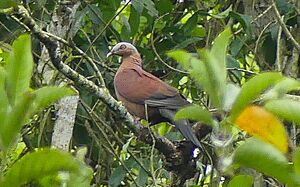Pale-capped pigeon facts for kids
Quick facts for kids Pale-capped pigeon |
|
|---|---|
 |
|
| Conservation status | |
| Scientific classification | |
| Genus: |
Columba
|
| Species: |
punicea
|
| Synonyms | |
|
Alsocomus puniceus |
|
The pale-capped pigeon (Columba punicea), also called the purple wood pigeon, is a large type of pigeon. You can find it in different places across the Indian subcontinent and Southeast Asia. This bird flies slowly and often sits still in the leaves of big trees that have fruit. It likes forests near rivers on flat lands.
This pigeon is mostly brown on top and a reddish-brown underneath. It has a shiny look, sometimes green or purple. Male pigeons have a whitish-grey cap on their heads. Females have a brownish-grey cap and are less shiny. These birds mostly eat fruit. They look for food in small groups high up in trees. Sometimes, they go down to the ground to find seeds and fallen fruit.
What Does It Look Like?
This large pigeon is about 36 to 40.5 centimeters (about 14 to 16 inches) long. It is mostly a dark reddish-brown color. Its pale cap stands out against its dark body.
The male pigeon has a whitish-grey cap. Its upper body is purplish-maroon with a slight green shine on its neck. Its back and shoulders are very shiny. The lower back and upper tail feathers are dark grey. Its cheeks, throat, and belly are reddish-brown. The feathers under its tail are grey, and its tail and flight feathers are blackish.
Female pigeons have a cap that is more brownish-grey. Young pigeons start with a cap the same color as their back. Their wing feathers are duller with reddish edges. They are less shiny on their upper parts and greyer underneath. Adult pigeons have red legs and creamy-yellow eyes. The skin around their eyes and their nose area are a bright pinkish-red.
Some bird experts group this pigeon with the Columba argentina pigeon. Both are Old World pigeons that do not have patterns on the back of their necks.
Where Do They Live?
The pale-capped pigeon lives in many places, but it is not common everywhere. Its wide range includes parts of northern and northeastern India, Bangladesh, Myanmar, Thailand, Laos, Cambodia, and Vietnam. The first pigeon of this kind that scientists studied came from Chaibasa, Singhbhum, India. However, there are not many records of it from Peninsular India.
People have seen this pigeon in Maharashtra, Orissa, Bihar, and Andhra Pradesh in India. Some observers thought it was a visitor to Sri Lanka during certain seasons. In parts of Thailand, they visit in winter. Birds have been seen resting in mangrove forests far from the main land.
These pigeons mainly live in forests on flat lands. They can be found in many different places, from lowlands up to 1,600 meters (about 5,250 feet) high. They prefer old or new evergreen forests. But they also live in open forests with deciduous trees, bamboo areas, and even farm fields. They especially like places close to forests. They probably only visit Mangroves, small forest islands, and other coastal areas when they are not breeding.
What Do They Eat and How Do They Behave?
The pale-capped pigeon mostly eats fruit. But in some areas, seeds and grains are also important parts of their diet. An observer named Tickell noticed these birds in groups of 4 or 5. They were mainly in Eugenia trees near rivers. They ate the berries from these trees. They would look for food in the morning and evening and rest during the hottest part of the day. Another observer, Layard, noted that they liked Cinnamon trees. This pigeon does not seem to have been common in most of the places it lives. It was once said to be common on an island called Koh Mur or Pulau Muntia in western Thailand. Recent reports show that it is now rare and hard to find in its range.
These pigeons fly around in small groups. They look for food mostly in the morning and evening. People say they make a low sound. It is similar to the sound of the Ducula aenea pigeon, but shorter. The breeding season is from May to August. They build a simple, flimsy nest low in a tree. They usually lay one egg, but sometimes two.


